Learn how to smoke a chuck roast on a Pit Boss pellet grill following our detailed instructions and recipe below.
This is an easy and affordable piece of meat to prepare like a brisket or to make into pot roast, shredded beef for tacos, and countless other dishes.
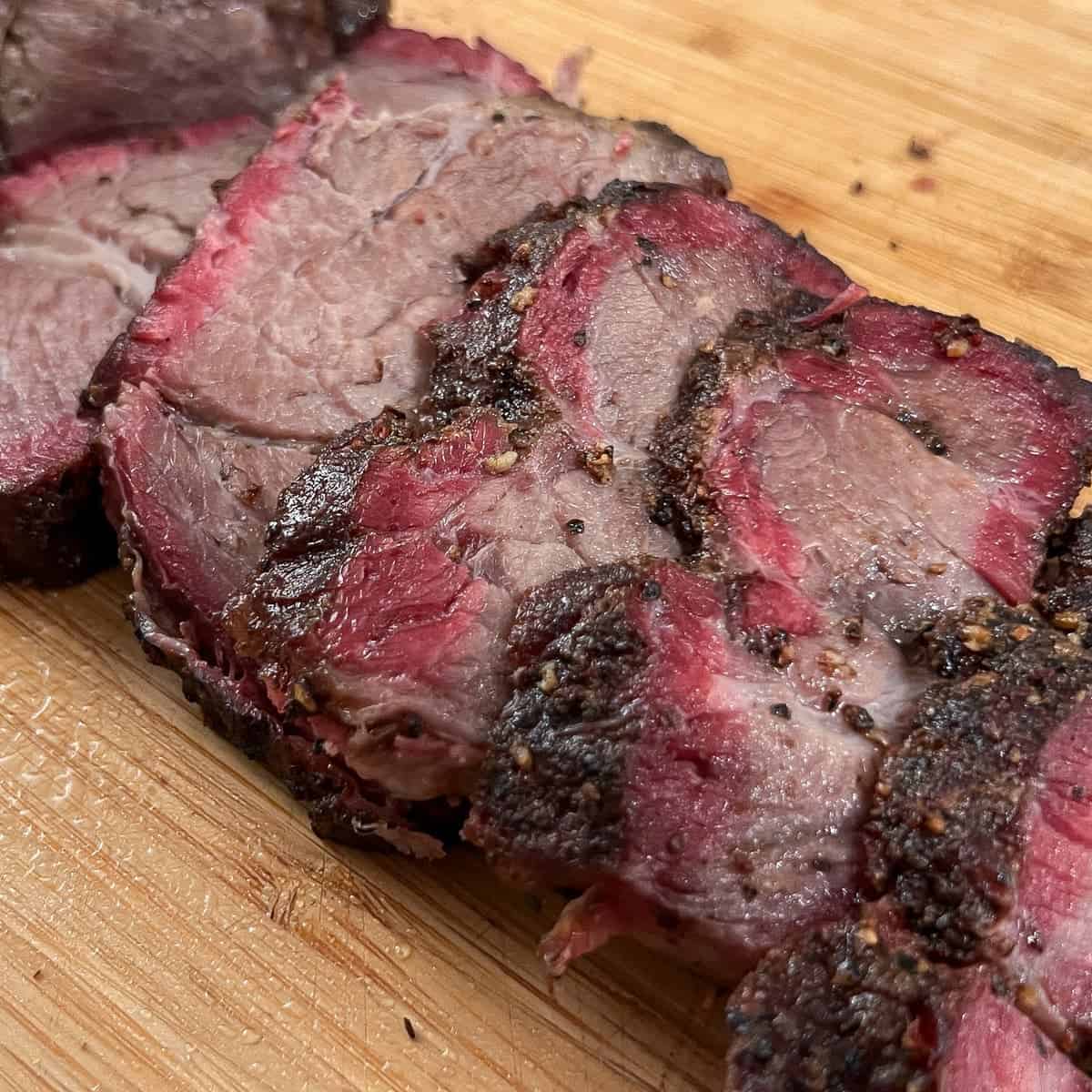
When it comes to smoking beef, a chuck roast is a great option for beginners, or those looking to feed a crowd without breaking the bank on a prime rib roast or beef tenderloin.
You've probably seen many a chuck roast thrown into a slow cooker all day to make "pot" roast.
That's because low and slow is the BEST way to cook this very affordable cut of beef.
Only instead of braising it with liquid in a pot, today we are going to slow smoke a chuck roast on our Pit Boss pellet grill!
Jump to:
- What is a Chuck Roast?
- Bone-In or Out?
- Size
- Video
- Seasoning with Rub
- Wood Pellets
- Wood Chunks in a Smoker Box
- Setting up the Pit Boss
- Smoking Temperature
- Cooking Time
- Marinade Injections
- Wrapping in Butcher Paper
- Final Internal Temperature
- Allow the Roast to Rest
- Unwrap and Slice or Shred
- Storing and Reheating
- 📖 Recipe
What is a Chuck Roast?
Much like a pork shoulder, or Boston butt, on a hog, a chuck roast is meat cut from the shoulder muscles of a steer, making it one of the best options for smoking pulled beef (or shredded beef, depending on which term you prefer).
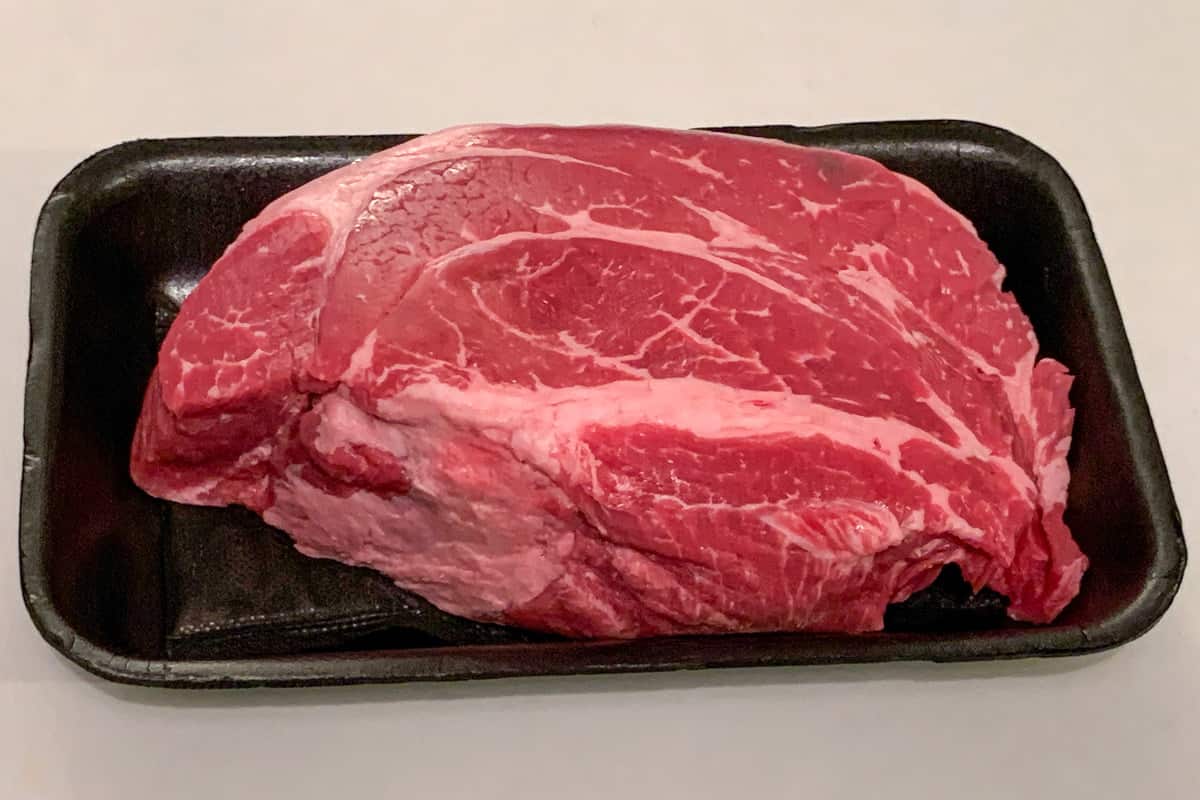
This area of the cow is above the brisket. Ground chuck is a popular choice for hamburgers.
Both chuck roast and brisket benefit from the same low and slow cooking method for tender meat. Unlike a full packer brisket, chuck roasts tend to be smaller and more affordable, making them a great alternative to brisket. In fact, chuck roasts are sometimes referred to as "poor man's brisket."
We compared the size of a large brisket to a large chuck roast in the photo below. You can see the brisket is considerably larger!
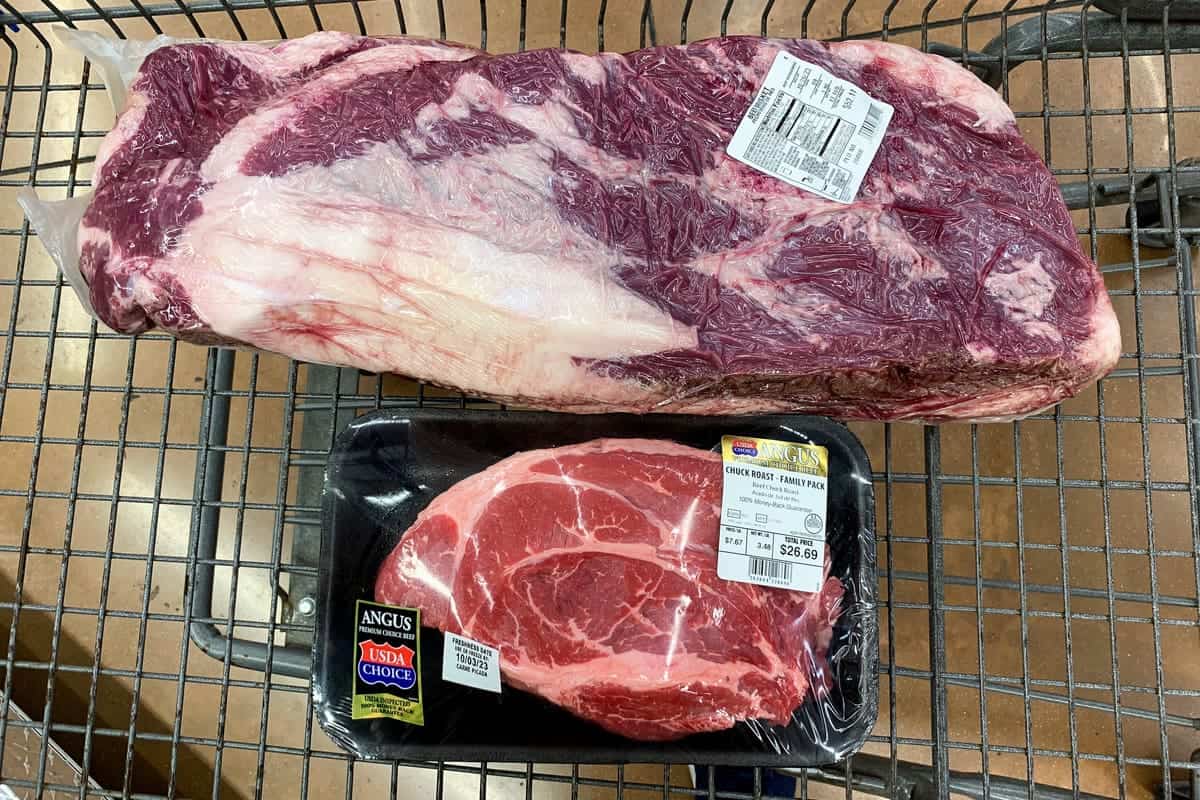
The seasoning is usually straightforward, as a simple dry rub can bring out all the flavors in the meat, and then a nice long smoky cook on the Pit Boss pellet grill will tenderize it.
After a whole day of cooking, one good sized chuck roast will feed a small crowd.
It can be served sliced like a brisket, or you can shred it to make sandwiches, tacos, or fajitas. You can also serve it like pot roast alongside some traditional carrots and potatoes.
Bone-In or Out?
You could go with the full chuck slab that looks similar to a brisket, or you can look for the blade cut version without the bone.
The bone can add flavor. But it will also increase the time it takes cook.
If you do get a bone-in chuck roast, there is no need to remove the bone before cooking.
It will slide out cleanly and easily after the chuck roast has been smoked, much in the same way one does on a perfectly smoked pork shoulder.
Size
The size of the chuck roast you choose to smoke on your Pit Boss depends on how many people you want to feed, but also on the time you want to spend smoking the meat.
A 3-4 pound chuck roast will take around 6-8 hours to smoke on a Pit Boss at 250°F (then 1 hour to rest) and will feed about 5-6 people as slices, or more if you are shredding it.
So yes, smoking a chuck roast on your Pit Boss can take all day.
There is also nothing wrong with smoking it the day before you serve it.
Smoked chuck roast will reheat wonderfully in the oven in an aluminum pan covered with aluminum foil.
We recommend adding a little beef broth to the pan to bring it back to life and infuse some additional moisture.
This way you can enjoy visiting with your guests rather than tending to the smoker on the day of your gathering.
Video
Rather Watch than Read?
Check out our step-by-step video on How to Smoke a Chuck Roast on a Pit Boss Pellet Grill!
Seasoning with Rub
You have lots of options for seasoning and preparing your Pit Boss chuck roast depending on the flavor profile you are going after.
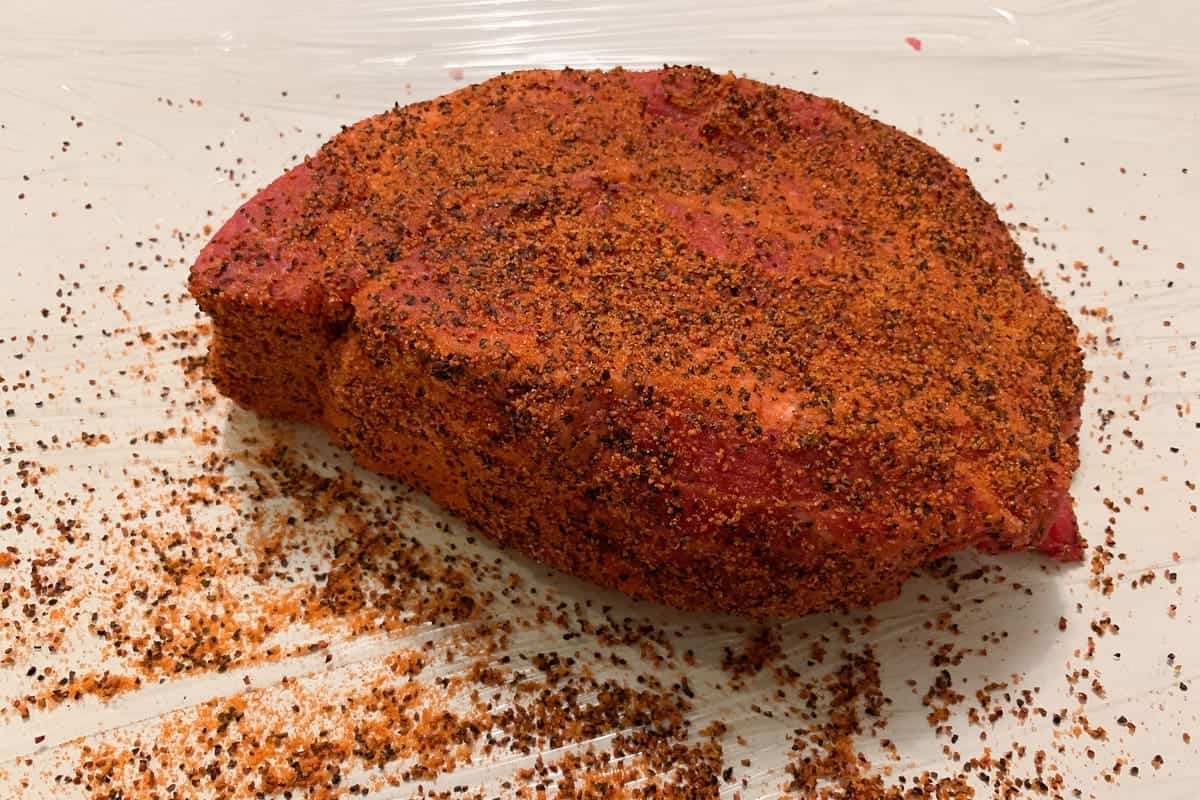
You can use anything from a traditional American BBQ rub to something more exotic or internationally flavored such as a spicy chipotle rub for fajitas.
Conventional American BBQ rubs have A LOT of sugar in them as that is what helps form the crusty bark on the exterior of ribs or a pork shoulder as it cooks in the smoker.
Because we are going to set our Pit Boss to only 250°F, you don't need to worry about any sugar burning at those "low and slow" temperatures.
However, unlike pork, which pairs well with sugary BBQ rubs, beef is usually better suited for more straightforward salt and pepper style seasoning.
You can add a little cayenne for extra heat or garlic and onion powder for additional flavor, but go easy on the rubs that are heavy in sugar content.
We are big fans of Bad Byron's Butt Rub Seasoning on smoked beef, especially brisket and chuck roast because it is heavy on flavor, and has no sugar.
It also works great anytime you are cooking something like our hot and fast brisket or a whole chicken, and you don't want a sugary rub to burn at those higher smoking temperatures.
- Try Bad Byron Butt Rub on fish, vegetables, potatoes, potatoes, eggs, popcorn and much more!
- All natural and gluten-free
Another great option for seasoning beef is Holy Cow from Meat Church. It contains no sugar as well. That is what we used for the chuck roast featured in this article.
- This beefy BBQ seasoning is fantastic on brisket, tri-tip and steaks, but can be applied to anything you like.
- Gluten Free, No MSG
After you've seasoned the chuck roast, you can wrap the it in plastic wrap and put it back in the refrigerator until you are ready to start up the Pit Boss.
We prefer to do this the night before to save some time the next day and to let the salt in the rub fully penetrate the meat.
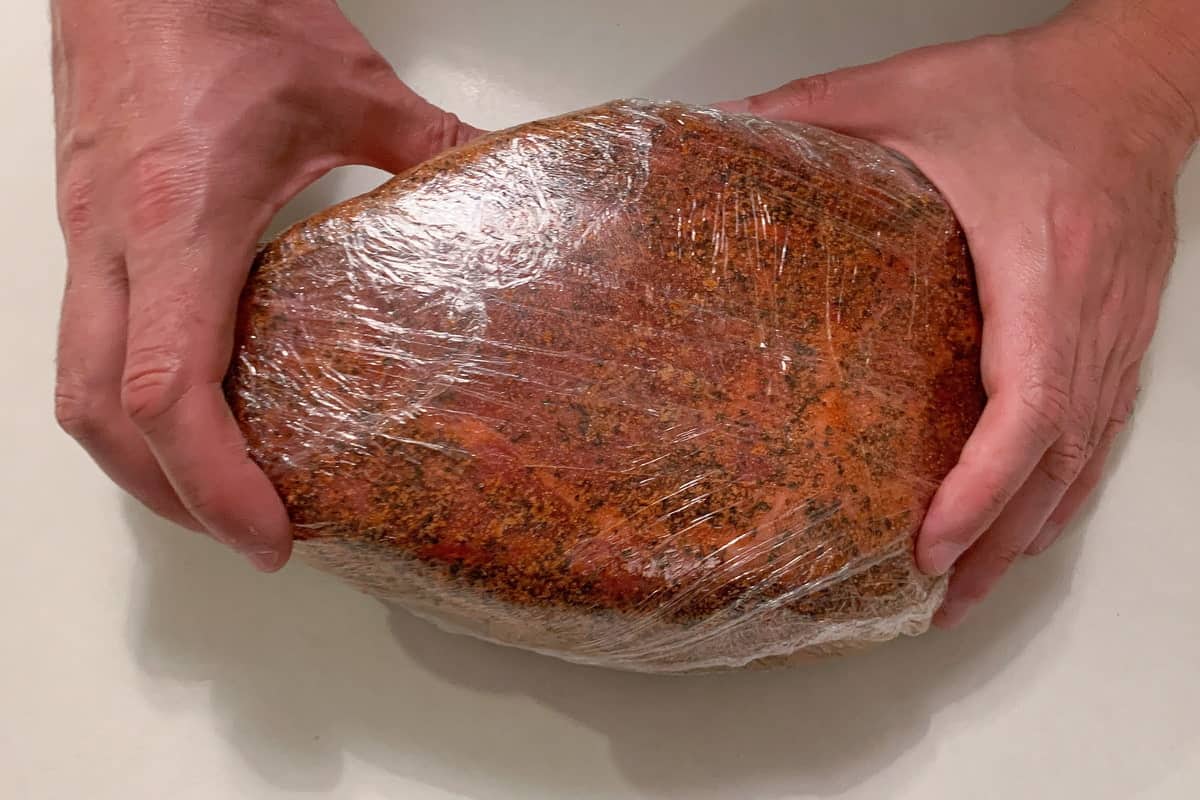
Wood Pellets
You have a lot of freedom when it comes to choosing the right wood pellets to smoke your Pit Boss smoked chuck roast.
Mesquite and hickory will give a very aggressive smoke flavor, so should mixed with milder wood pellets so as not to overdo it.
Alternatively, you can also go for an overall milder smoke flavor by choosing oak or fruitwood pellets.
Pecan, apple, beech, alder, and cherry all give great results on smoked chuck roast.
For a straightforward smoke right out of the bag, we are big fans of Bear Mountain Red and White Smoky Oak Pellets.
Lately we've really been loving Knotty Wood Almond Cabernet Wine Blend pellets. You can tell when looking at them that they have a wide array of wood colors and the pellet are sturdier.
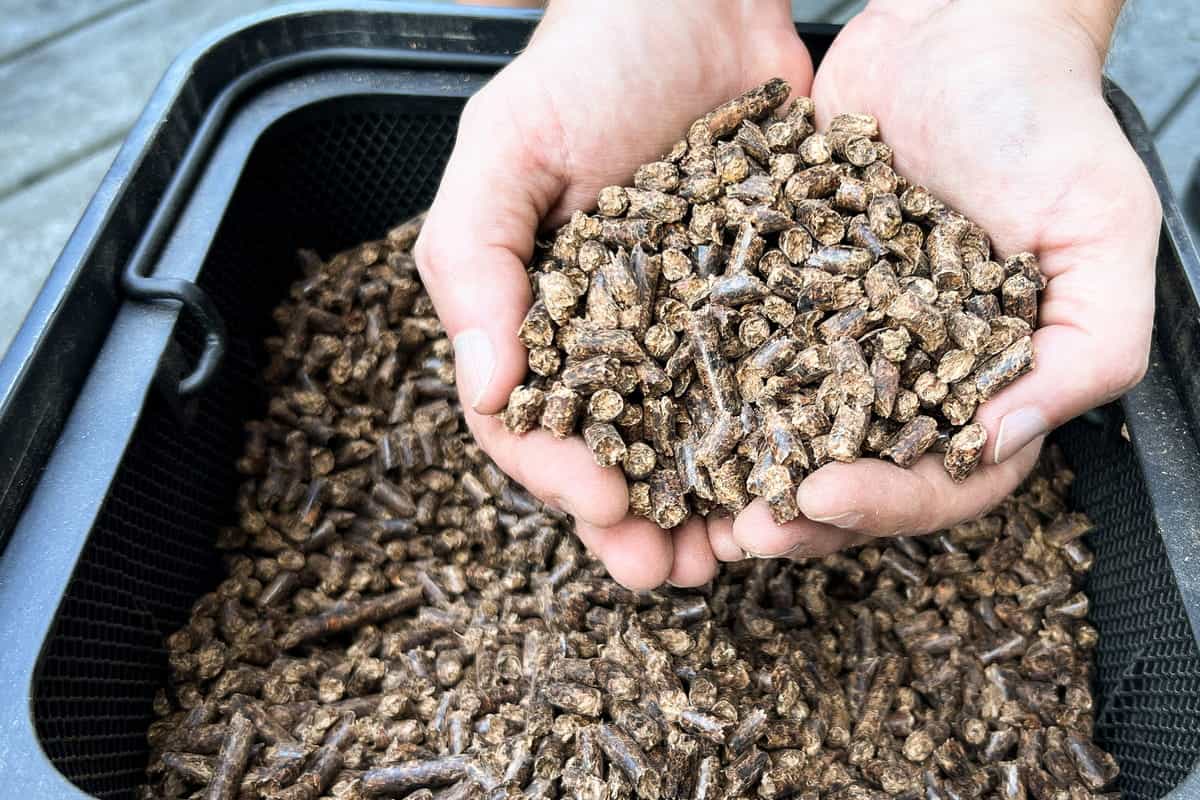
They are more expensive that most other brands of pellets, so what we like to do is use the less expensive pellets in the hopper and place the more expensive pellets in a pellet tube smoker. This gives you the most smoke flavor from a much smaller amount of pellets.
- Oak pellets add well-balanced smooth and smoky flavor while grilling or smoking food
- Made from 100-percent all-natural hardwoods with no flavorings, fillers, or additives
- Low moisture content provides the perfect smoke and adds a well-balanced flavor to your favorite dishes
For the best results, store your unused pellets in a sealed room temperature container like this 20 lb pellet container rather than in the Pit Boss hopper outside.
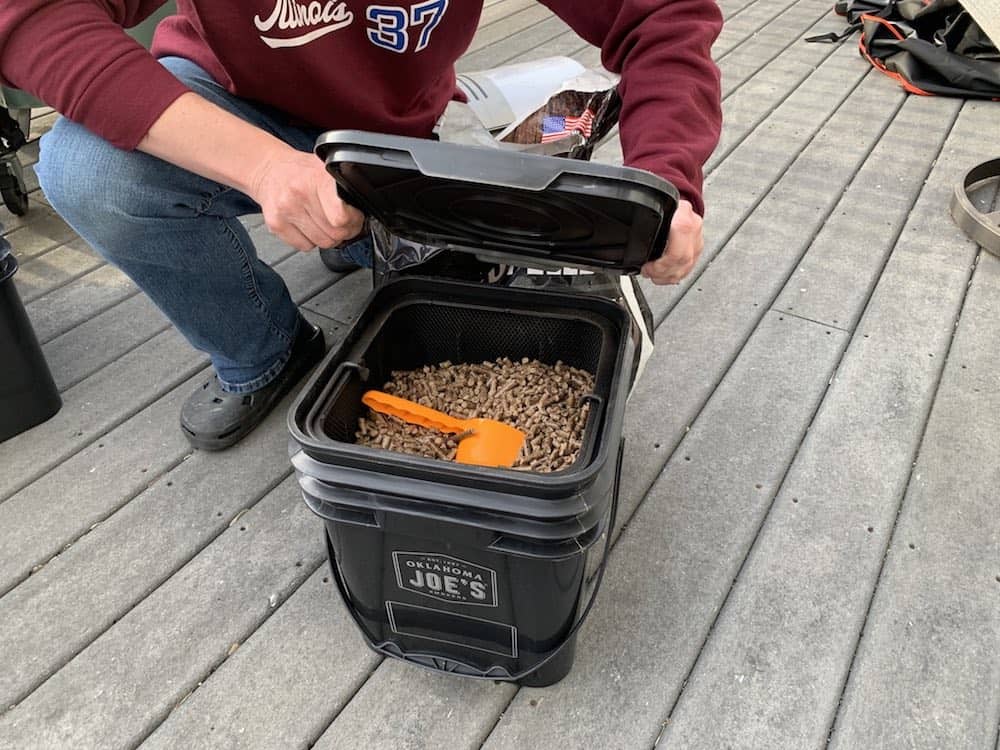
Pellets do not last forever, but will definitely last a LOT longer if stored indoors in a quality airtight container.
- Store up to 20 pounds of hardwood pellets in the heavy-duty plastic pellet bucket.
- Weatherproof, airtight lid protects pellets from the elements, keeping them fresh and dry
- Wire-mesh filter separates wood dust from the pellets for a clean burn
- Heavy-duty plastic scoop to easily transfer pellets
Wood Chunks in a Smoker Box
An alternative to using a pellet tube to get more smoke flavor on your chuck roast is to use real wood chunks and charcoal in a smoker box. We have a video showing you exactly How to Light a Firebox for a Pellet Grill.
For chuck roast we like cherry wood chunks. We feel the flavor is not too overpowering for a longer smoking period.
Setting up the Pit Boss
We have previously covered how to season a Pit Boss, how to start a Pit Boss, how to easily install the top rack of a Pit Boss, as well as how to troubleshoot the smoke level of your pellet grill.
So if you need a more in-depth review on how to use your Pit Boss for the first time, check those articles out first!
We prefer to smoke the chuck roast on the top rack, while reserving the bottom rack for the smoker box and a large disposable aluminum pan filled with water. The water pan not only provides some moisture to the air of the cooking chamber, but it also serves as a barrier over the firepot to help diffuse the heat and facilitate the low and slow cooking for which we are aiming.
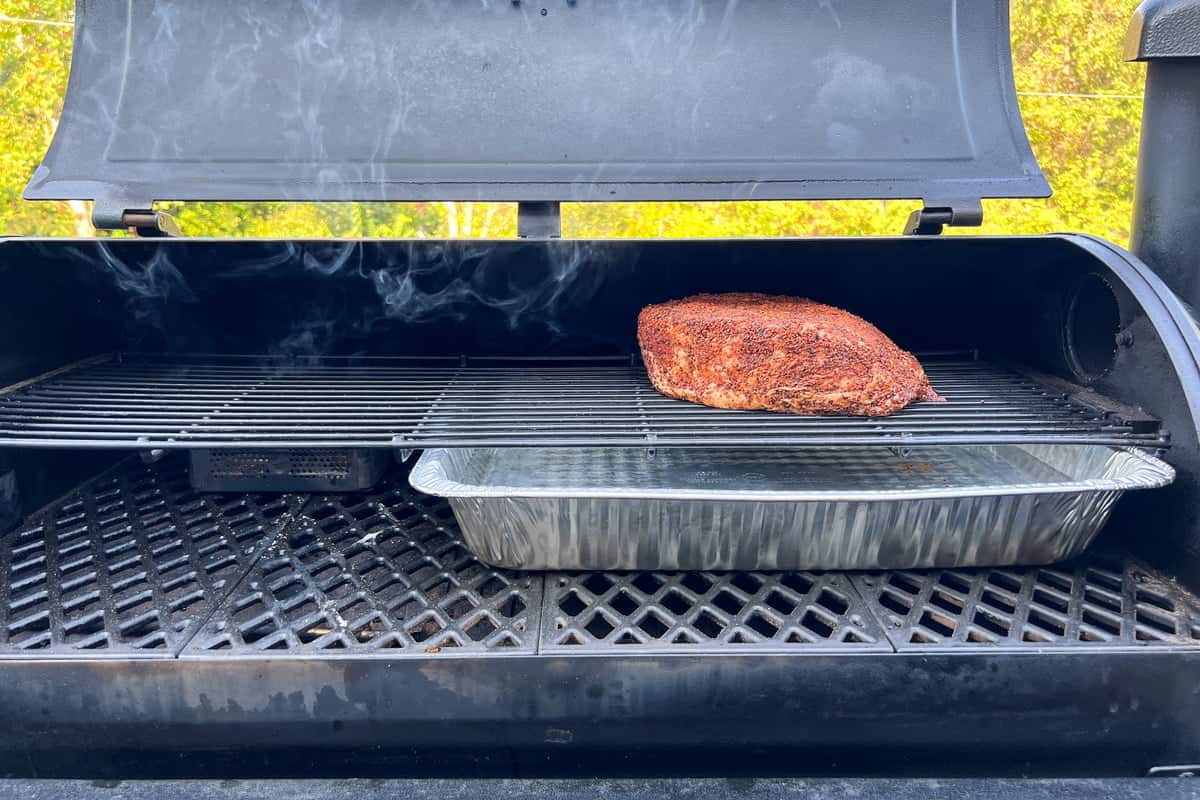
Smoking Temperature
After going through the startup process described above, set the temperature to 250°F, and let the Pit Boss come up to temperature.
We are going to cook the chuck roast low and slow to a high final temperature, similar to a beef brisket, rather than cooking it to a certain doneness like a prime rib or a good cut of steak.
This is because chuck roast has more fat and connective tissue that needs to break down, and it will taste better cooked this way.
Cooking Time
At 250°F, it will take roughly 1.5-2 hours per lb to fully cook a chuck roast to the point where you can pull or shred it.
So a 3-4 lb chuck roast may take anywhere from 6-8 hours.
This will vary based on outdoor temperature, humidity, the fat content of the chuck roast you purchased and whether or not is is bone-in or boneless.
For that reason, we recommend going by internal temperature, not time. This is our mantra for BBQ.
Make sure to use a good temperature probe to keep track of your meat's temperature while it is cooking.
We are big fans of this one from ThermoPro.
- Professional digital meat thermometer with timer mode and colored light system
- Preset temperatures for 9 types of meat and their various doneness levels recommended by USDA
- Count-up and countdown timer ability up to 23 hours, 59 minutes
- Probe wires are Rated for 716°f
- Our intuitively designed probe thermometer allows for you to see both the meat cooking thermometer mode and countdown timer mode on the display without having to press a button to rotate between both modes
- Certified by NSF
While we have used and recommended ThermoPro for years, lately we have also become big fans of the MEATER leave in thermometer.
It is extremely accurate and has a 165 foot Bluetooth range that works right with your smartphone so you don't need to carry a separate controller around with you.
It has a free app that is constantly being updated and even has an algorithm to predict how much longer your type of meat will take to cook based on cooking temperature, target temperature, and current internal temperature.
It's like a GPS for your meat!
- ► 2 Sensors, 1 Probe: Dual temperature sensors can monitor internal meat temperature up to 212°F and ambient / external temperature up to 527°F simultaneously. Dishwasher safe.
- ► Advanced Estimator Algorithm: Can estimate how long to cook and rest your food to help plan your meal and manage your time.
- ► Connectivity Suite: Monitor your cook from a phone or tablet over Bluetooth. Extend your range Using MEATER Link WiFi and MEATER Cloud to use Alexa and monitor your cook from a computer.
Marinade Injections
For additional flavor, some BBQ cooks like to inject their chuck roast with a marinade during the cooking process.
The idea is to add flavor and moisture deep into the meat to help season the bland interior of the beef while its cooking.
We think an injection is completely worth it under certain circumstances.
We LOVE to inject meats that will be served sliced like smoked brisket, ham, and turkey.
The only problem is it adds water weight and significantly extra time to your cook.
By adding 8 oz of injection to your smoked chuck roast, you may be increasing your cooking time by an hour or even more.
If you think about it, when the chuck roast comes off of the Pit Boss, you are going to be pulling it apart in a big tray, and adding seasoning at that point too.
The same holds true when we do a big pork shoulder that will be used for pulled pork. We find injection unnecessary.
If you plan on slicing your chuck roast, like we did for the one featured in this article, an injection is a good idea to ensure you have flavor all of the way through the meat.
Always use a good quality meat injector like this one.
For chuck roast, we recommend a blend of beef bone broth, Worcestershire, and a little melted Wagyu beef tallow for some added richness.
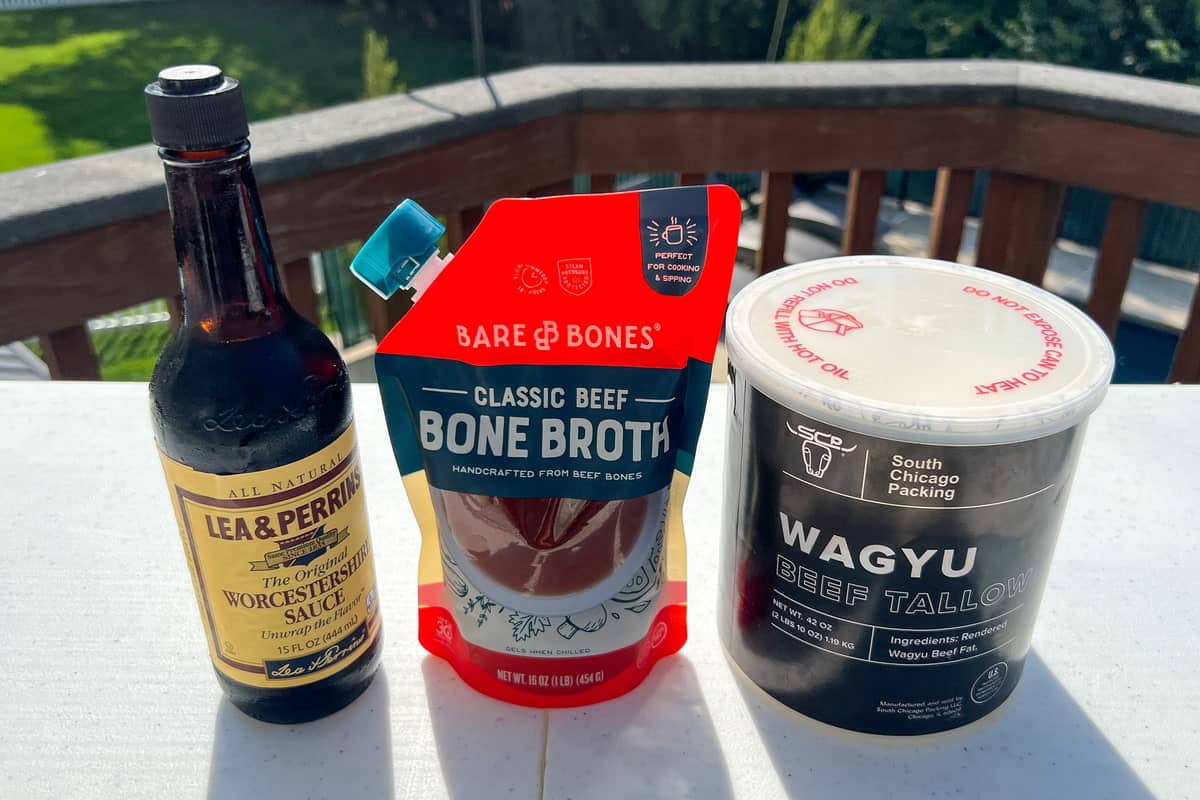
Other ideas include some soy sauce or Bad Byron's Butt Rub mixed in as well.
While the tallow is solid at room temperature, you can add it to a bowl with the other ingredients and place it in the smoker for a few minutes to melt the tallow. Then give the mixture a good whisk to create an emulsion.
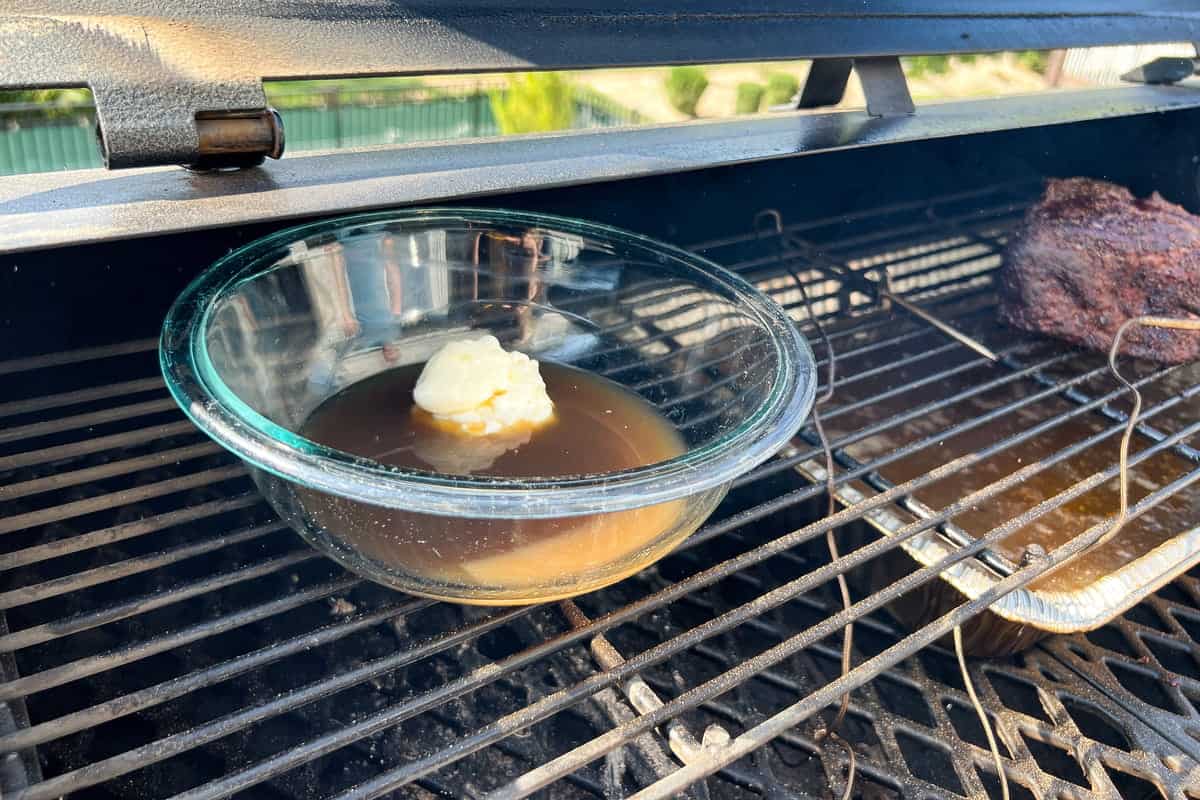
Draw the marinade up into the meat injector, pierce into the meat, and inject the marinade. Repeat all over the meat, including going in from the sides.
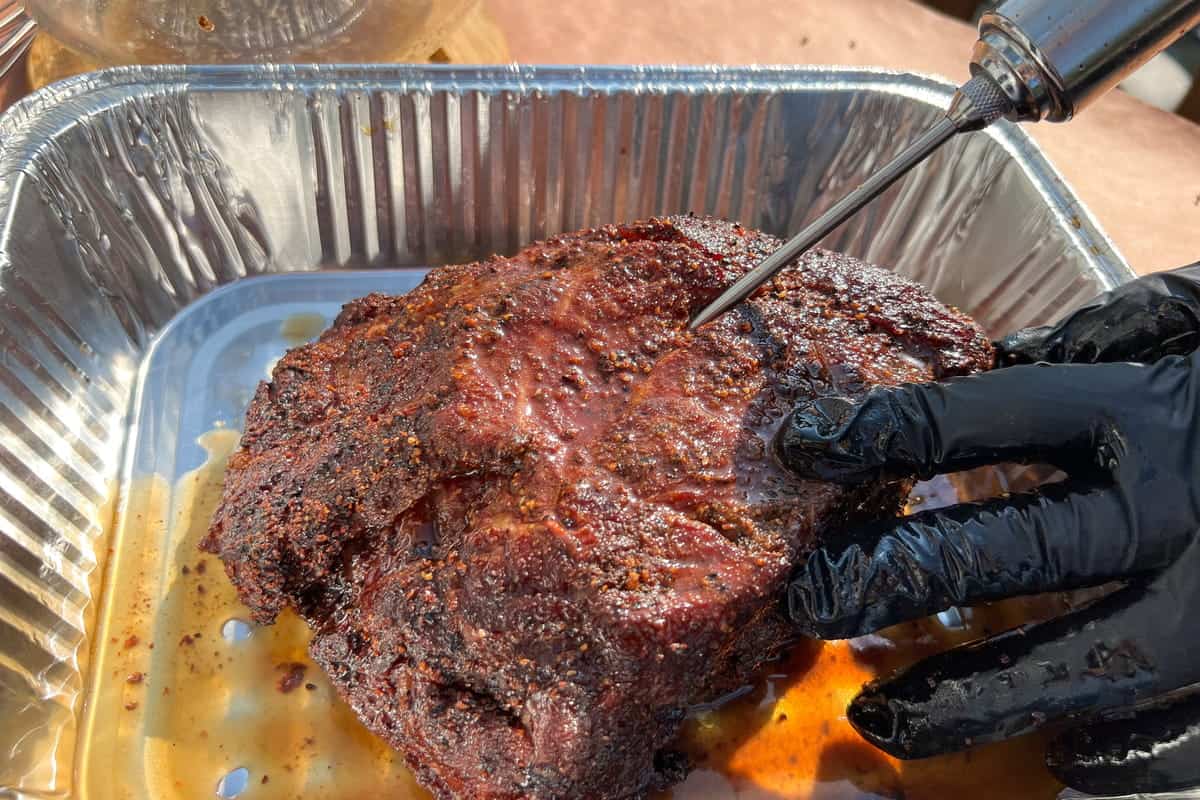
We recommend waiting to inject until your roast is ready to wrap, then injecting and immediately wrapping in butcher paper.
- Enlarged Pressure Surface
- Safe & Sturdy Materials
- What You Will Get--1 BBQ injector kit; 3 meat syringe needles; 2 cleaning bush; 6 silicone O-rings
Wrapping in Butcher Paper
When big pieces of meat like brisket or pork shoulder are being cooked low and slow, and hit about 150°F internally, they tend to "stall out" and stop rising in temperature.
Sometimes for hours depending on the size of the meat.
Without getting too much into the science behind why this happens, just understand it has to do with a lot of trapped moisture evaporating at this temperature and continually cooling your meat as it evaporates.
One way to "power through the stall" is to wrap the roast in pink butcher paper like you would a brisket.
- TENDER MEAT
- FOOD GRADE, SMOKER SAFE
- HEAVY-DUTY
- UNWAXED
To know when it's time to wrap the roast depends on a number of factors. You want the roast to have reached a minimum of 150°F internally, but going higher is fine.
You want a nice bark to have formed to where the seasoning is not longer moving around on the surface of the meat.
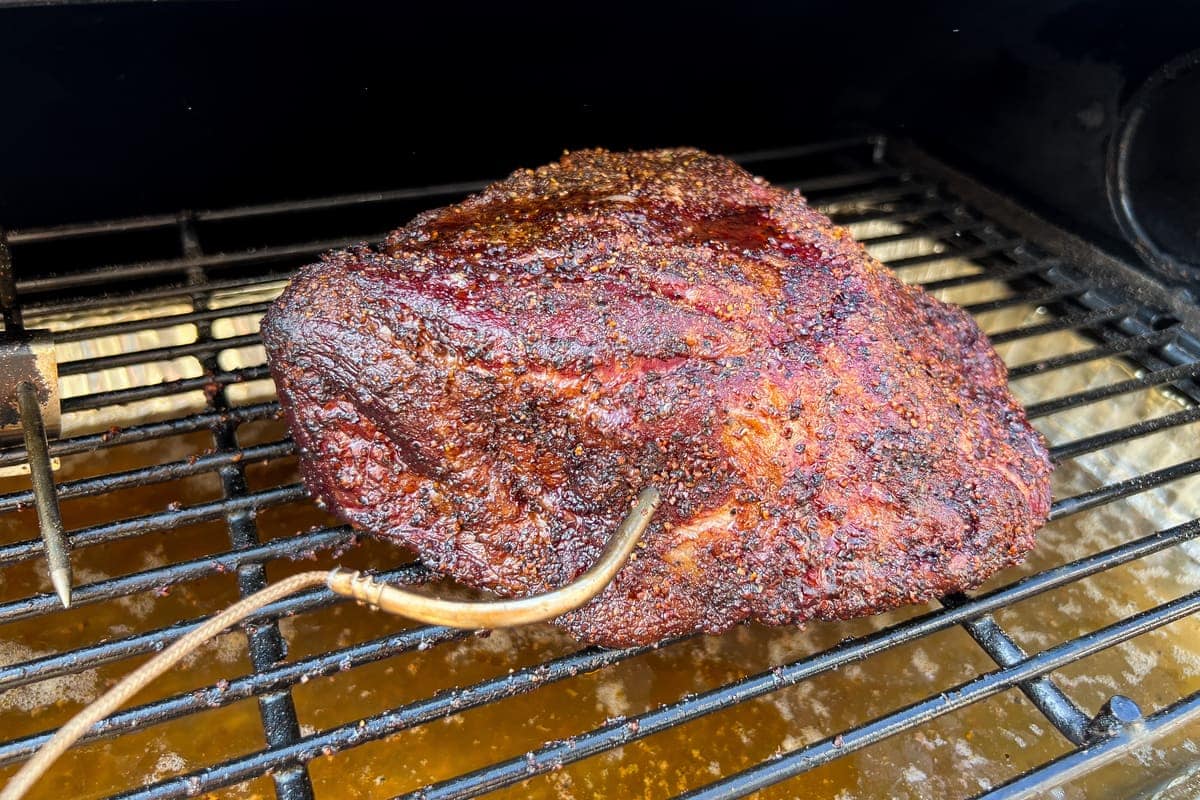
Also you will notice juices flowing when you poke the outside edges of the roast to indicate that the fat has started to render.
To wrap the roast, unroll a large piece of chemical-free butcher paper. Spray it with water or apple cider vinegar to make it more pliable and keep the roast moist.
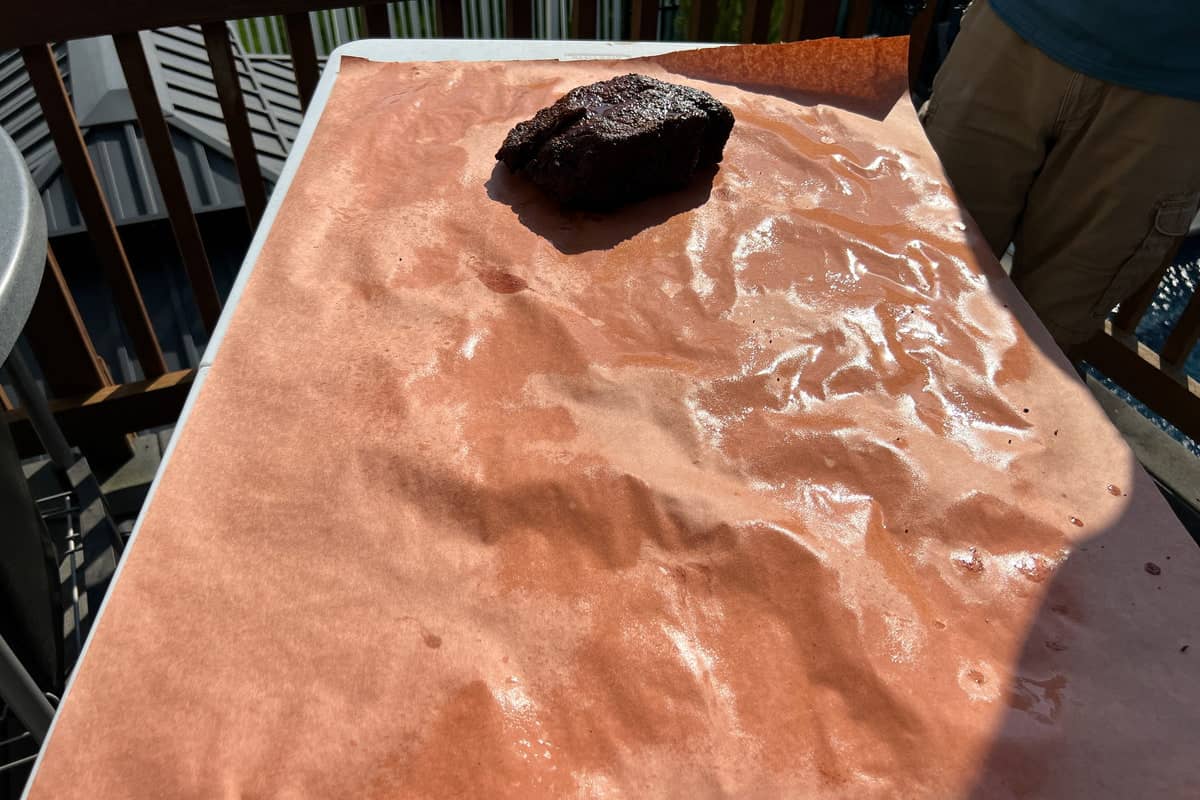
Position the meat toward one end of the paper. Fold the paper over on top of the meat and then flip it. Tuck in the sides, then fold each side along the length before rolling it down and tucking the excess in.
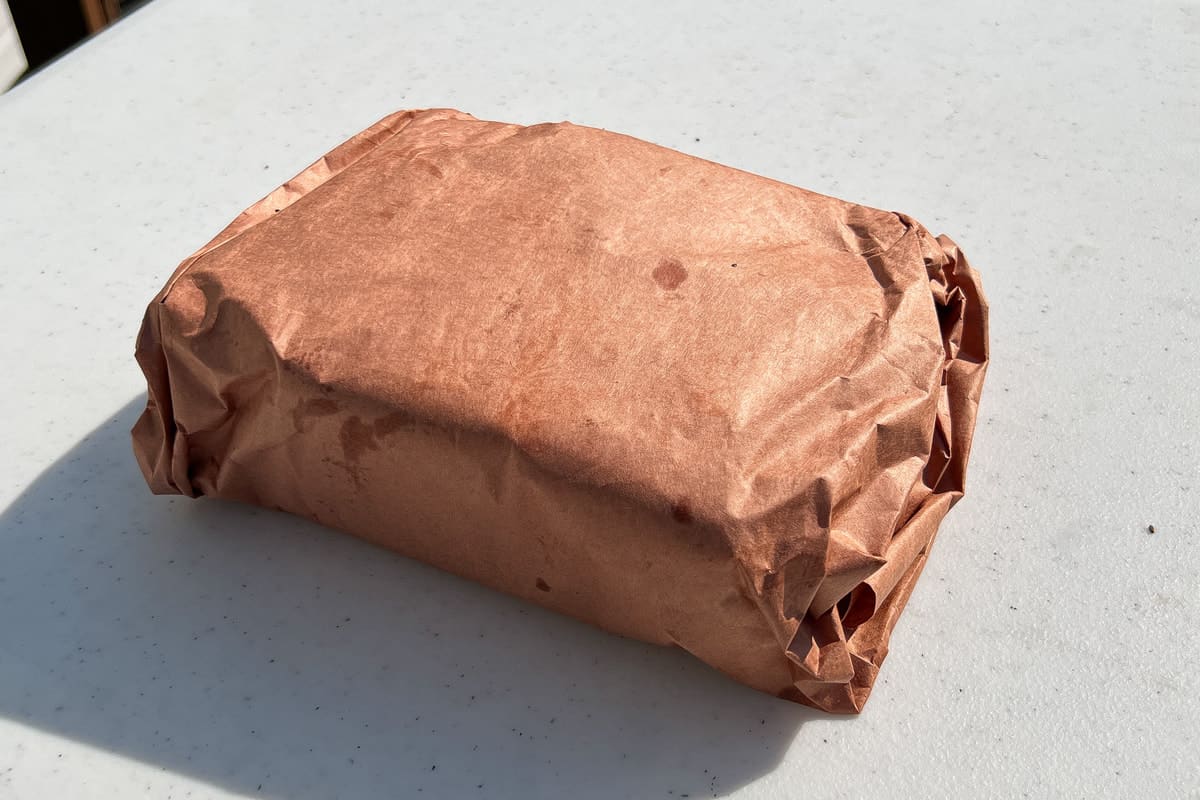
For a visual on how this is done, we like this video tutorial on how to wrap a brisket. While this is a chuck roast, the method is the same.
Then replace your thermometer by punching it through the butcher paper, place the meat back on the Pit Boss, and let it continue to cook.
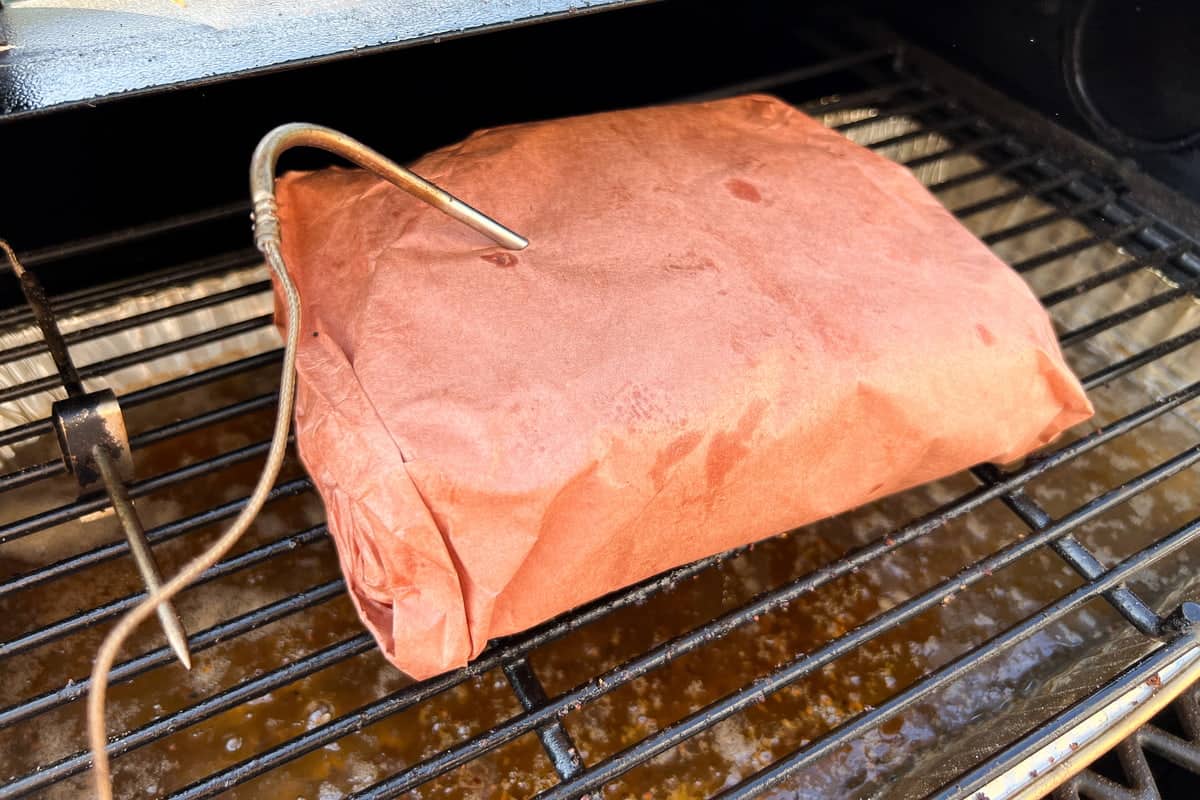
The butcher paper will keep the moisture from evaporating, keeping your meat from drying out as much while to cooks, and most importantly, let it continue to steadily rise in temperature.
Final Internal Temperature
You are going to leave your chuck roast on the Pit Boss until it hits somewhere between 200-205°F when measured with a good temperature probe or instant thermometer.
Don't rush it!
Chuck roast is not a cut of meat you want to serve medium or even medium well like a nice ribeye roast.
There is too much intramuscular fat and connective tissue that needs to break down and render at higher temperatures.
The chuck roast will be tough and unappetizing if you cook and serve it like a beef tenderloin or prime rib roast.
Smoked chuck roast is best served when cooked to 200°F internally, allowed to rest, and then sliced or shredded.
It will not be fall apart tender or pull well even if you take it off the Pit Boss at 180°F.
Allow the Roast to Rest
Once the roast has reached an internal temperature of 200-205°F, it is ready to rest. Remove it from the smoker to an aluminum foil pan. Do NOT unwrap the meat just yet.
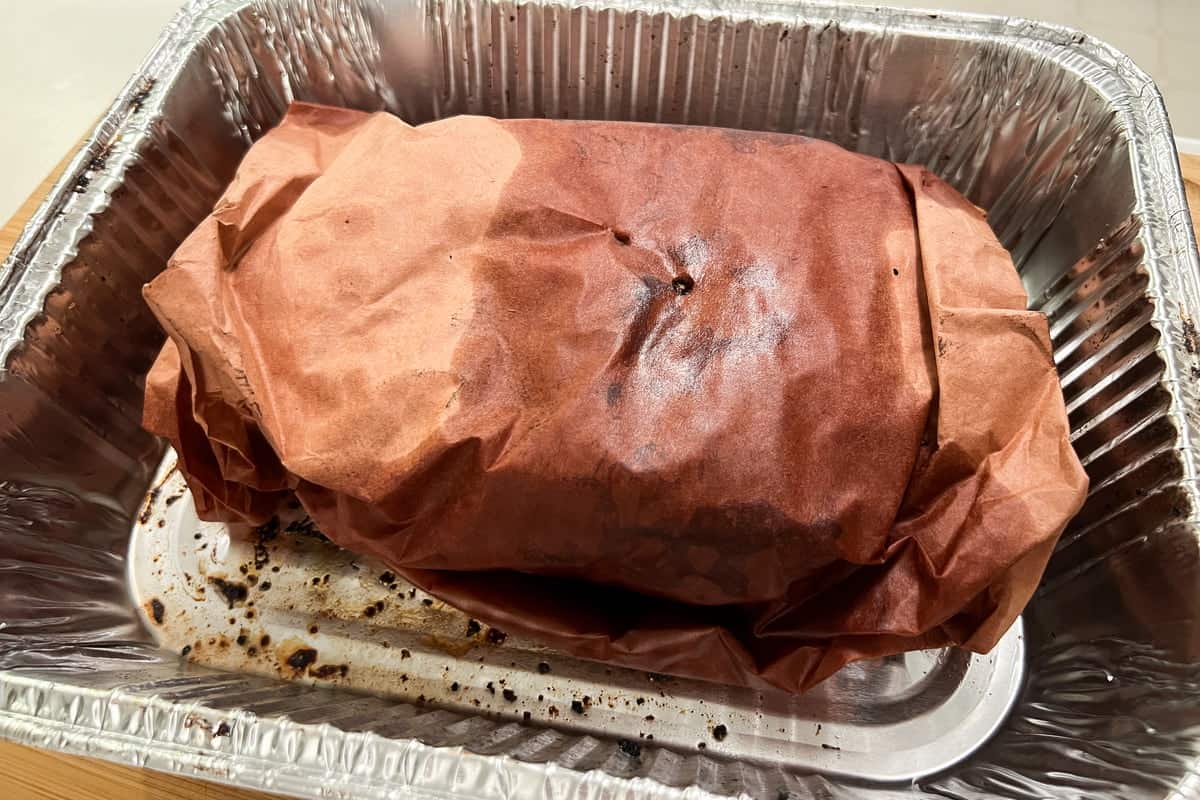
You can allow it to rest at room temperature for 1 hour, but ideally you should place it in a warm (170°F oven) to keep it warm and at a food safe temperature. Another option is to place it in an empty cooler to keep it warm while it rests.
Unwrap and Slice or Shred
After 1 hour, you can unwrap the roast.
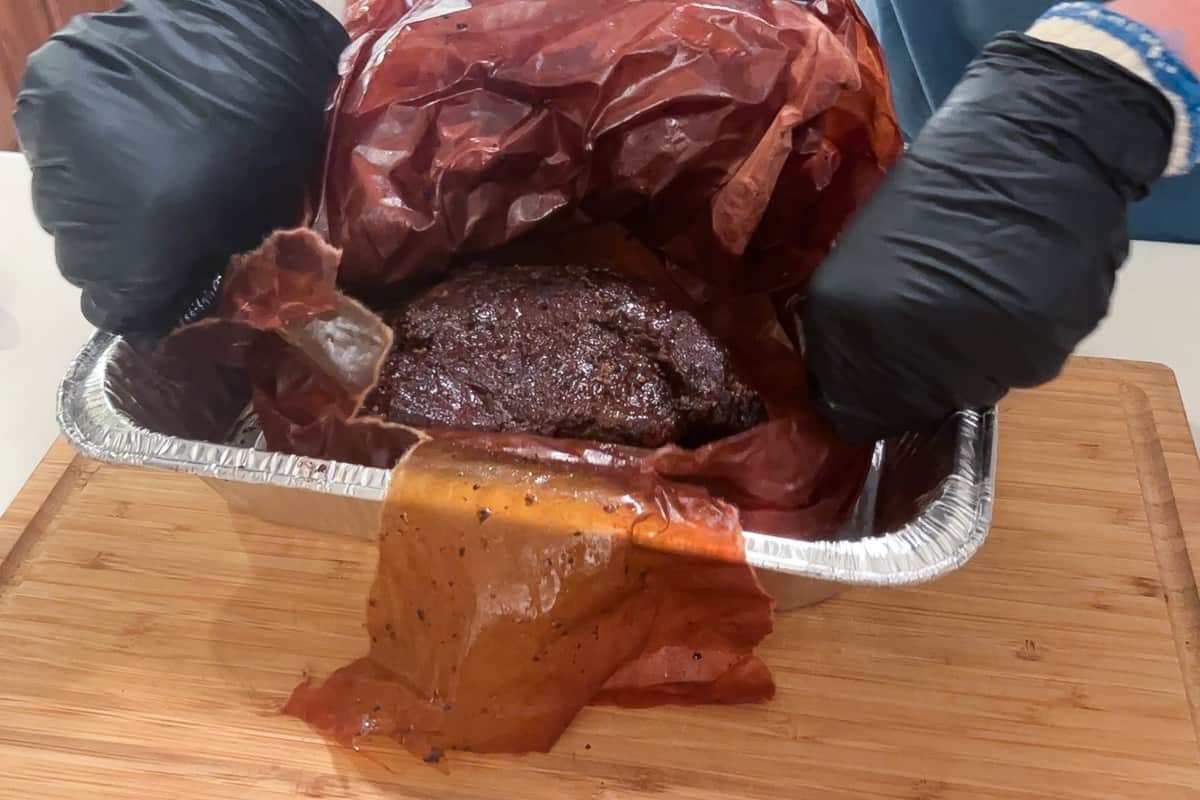
Use a good meat slicing knife to cut thin slices of the roast.
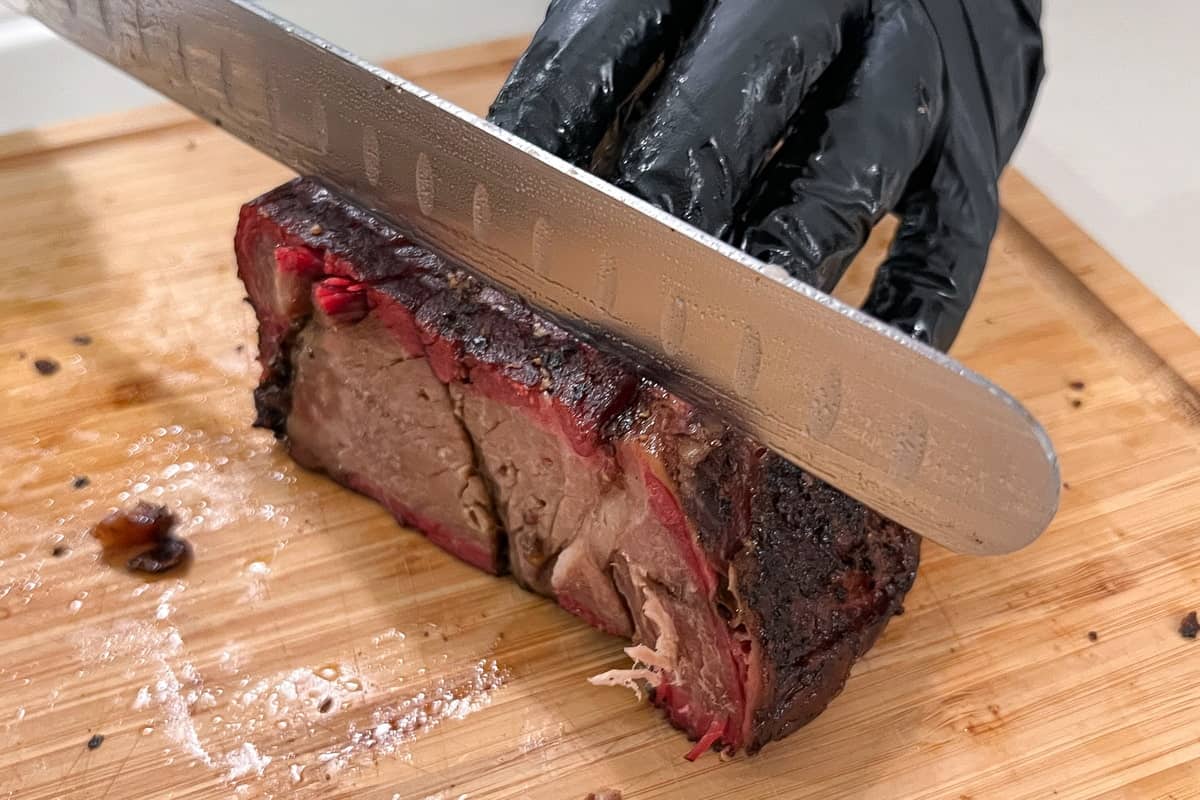
- VERSATILE: This 11” slicing knife works well with different types of meat. Long enough to cut through brisket, pork loins, turkey, ham, smoked salmon and roast. It can also be used to slice fruits and vegetables.
- TOP PERFORMANCE GUARANTEE
If you smoked the meat well, you should see a pink smoke ring around the edges of each slice.
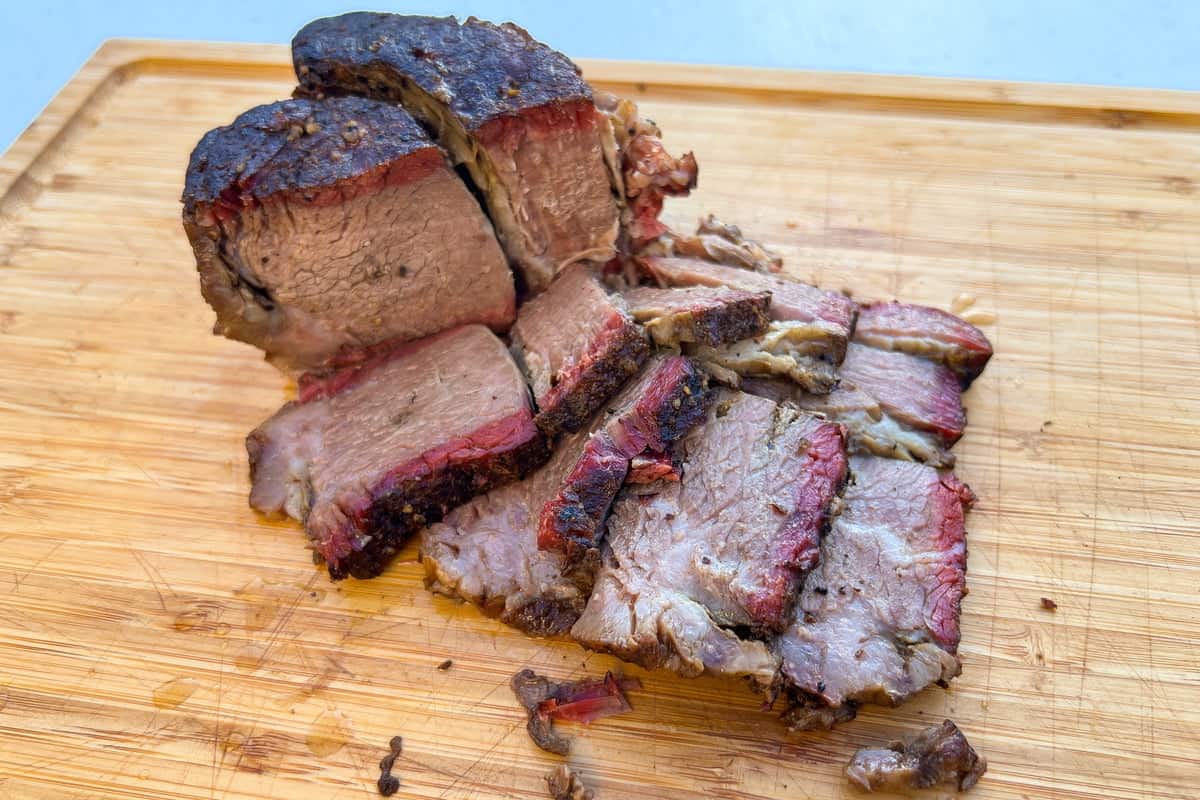
Sliced smoked chuck roast is great as a main dish alongside some Smoked Carrots and Smoked Mashed Potatoes. We like it on a sandwich with some sliced pepperoncini peppers and some Blues Hog Championship BBQ sauce.
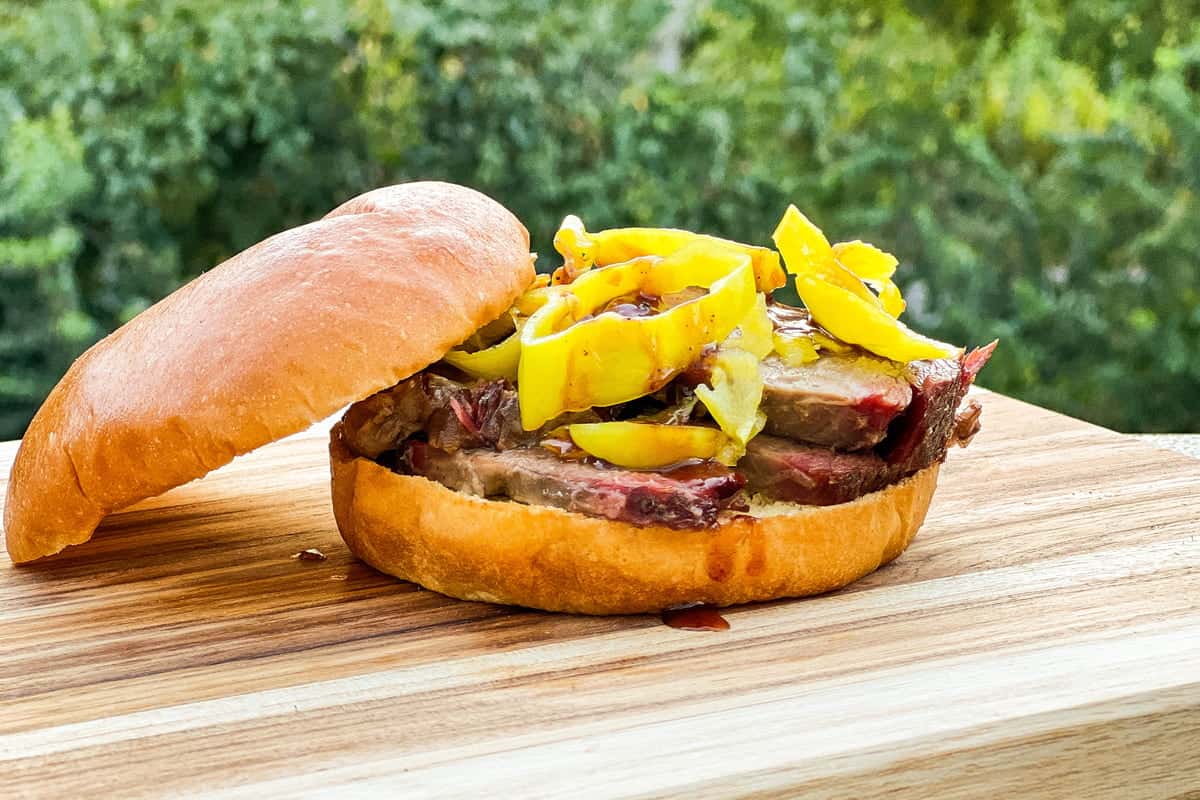
For shredded beef, you can use 2 forks or, better yet, a pair of BBQ Bear Claws to make the job even faster (and fun)!
- The Ultimate BBQ Shredder Claws for Pulled Pork, chicken, brisket, turkey, ham, roasts
- Protection against melting and Dishwasher safe
- Very Easy to Clean
Once you have pulled the meat, taste test it for seasoning, you likely need to add some more salt, beef stock, or some more Bad Byron's Butt Rub.
Add a little salt at time, mixing it in and re-taste testing as you go.
Storing and Reheating
For sliced or shredded chuck roast, store leftovers in the refrigerator in an airtight container.
When you are ready to reheat it, you can add a little additional beef stock to liven it back up and put it in the oven in a dish covered in foil at 325°F and reheat for about 30-45 minutes depending on the amount of beef.
Stir it occasionally and check the temperature to get it the point of being piping hot without overcooking it or drying it out, somewhere around 180°F with an instant read thermometer.
📖 Recipe
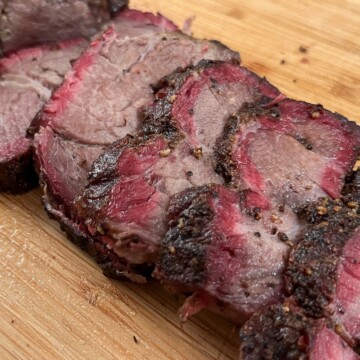
Pit Boss Smoked Chuck Roast
Equipment
- Pit Boss Pellet Grill
- Pit Boss Wood Pellets
- Knife
- Cutting Board
- Pink Butcher Paper
- Aluminum Foil Trays
- 2 Large Forks or a Pair of BBQ Bear Claws
- Internal Meat Thermometer
- Plastic Wrap
- Spray Bottle optional
Ingredients
- 3-4 lb Chuck Roast
- ¼ Cup BBQ Rub
Marinade Injection (optional)
- 1 Cup Beef Broth or Stock
- 2 tablespoon Wagyu Beef Tallow
- 2 tablespoon Worcestershire Sauce
Instructions
Apply the Rub
- Sprinkle the roast generously with BBQ rub on all sides.
- Wrap your chuck roast in plastic wrap and place it back in the refrigerator for at least 2 hours, preferably overnight.
Start the Pit Boss Pellet Grill
- Add your chosen pellets to the hopper, start the Pit Boss pellet grill, let it run through the startup cycle, and set the temperature to 250°F. Make sure the top rack is installed.
- Fill a large aluminum pan with water for extra moisture and heat diffusion, and place it on the bottom grates.
- If using a pellet tube or smoker box for added smoke, place it towards the back of the smoker on the lower shelf, away from the temperature probe.
Smoke the Chuck Roast
- Remove the chuck roast from the refrigerator and from the plastic wrap. Add some additional leftover rub if any came off, and when the Pit Boss has reached 250°F, place your meat directly on the right of the upper rack.
- Place a leave in thermometer inside the roast making sure to not touch the bone (if the roast is not boneless).
- Close the lid to the Pit Boss and allow the meat to cook and absorb smoke.
- Smoke the chuck roast until it reaches about 150-160°F internally and until a bark has formed and the fat has begun to render.
Inject the Marinade
- Whisk together the marinade ingredients.
- Using a meat injector, draw up the marinade and inject it into the roast in multiple spots along the top and sides.
Wrap in Butcher Paper
- Unroll a large piece of pink butcher paper onto a work surface. Spritz the paper with water.
- Place the injected chuck roast toward one end of the paper.
- Roll the paper over the roast, then roll the roast one time and tuck in the sides of the paper. Tightly roll the roast up, tucking in the final flap of paper. You want it to be tight and not have gaps of air.
- Replace the temperature probe by piercing it through the butcher paper and place the wrapped roast back on the top shelf.
- Continue cooking until the internal temperature reaches between 200°-205°F.
- Remove the roast from the smoker and place in an empty aluminum pan. Let it rest for 1 hour in a warm (170°F) oven.
Slicing or Pulling the Beef
- Unwrap the roast from the butcher paper.
- For sliced beef, move the roast to a cutting board and use a good meat slicing knife to cut thing slices.
- For pulled beef, keep the roast in the aluminum pan and use a pair or forks or bear claws to shred the meat. Discard any large pieces of fat and the bone, if applicable. Taste for saltiness and add salt, pepper, leftover rub, and/or beef stock as needed for flavor and moisture.












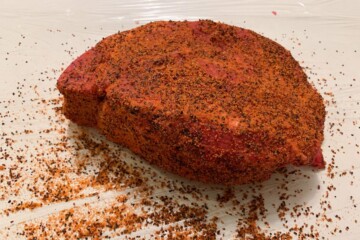
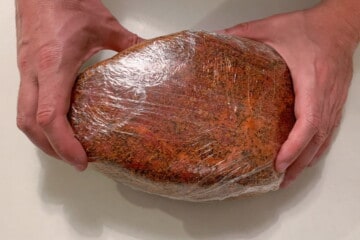
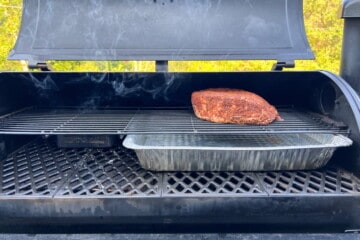
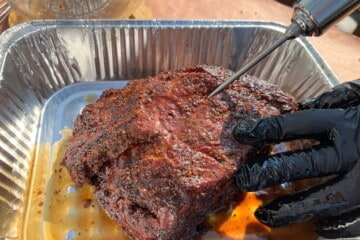
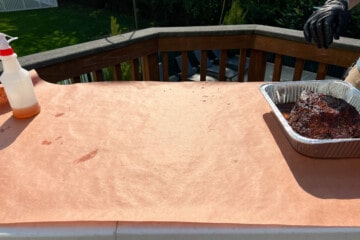
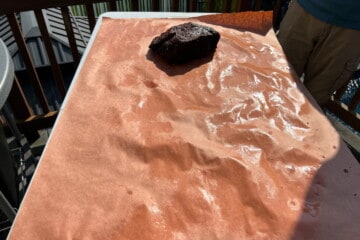
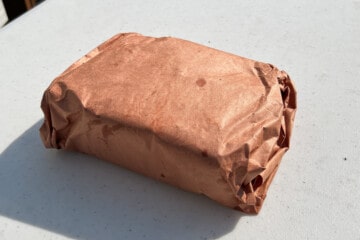
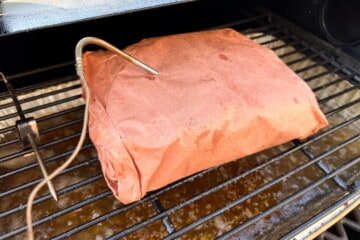
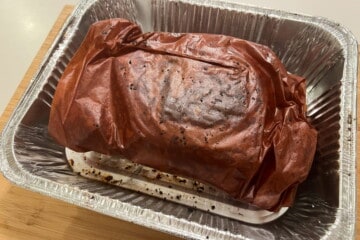
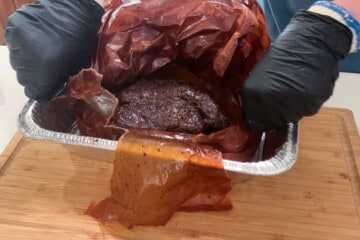
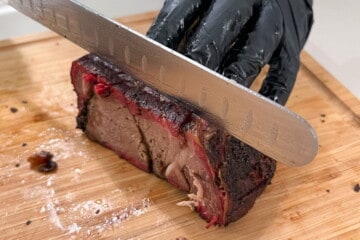
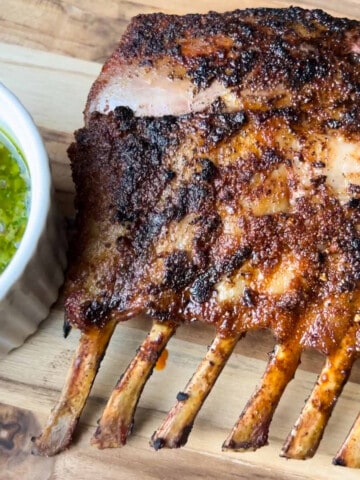
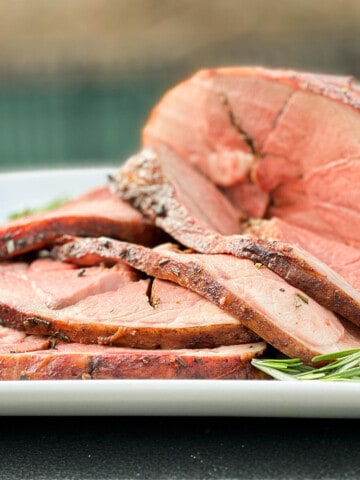
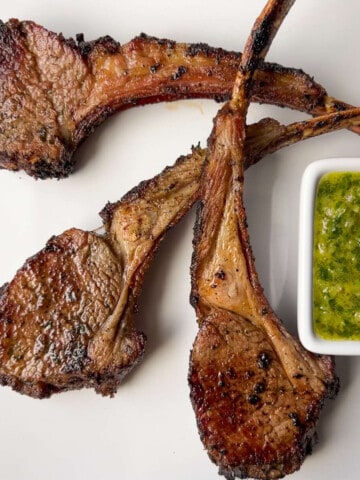
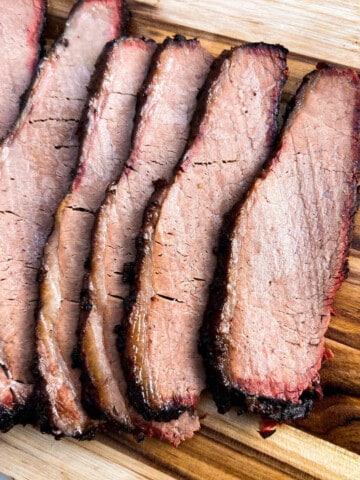
Joe says
You can also slice this like brisket and save some money! Thanks for the recipe.